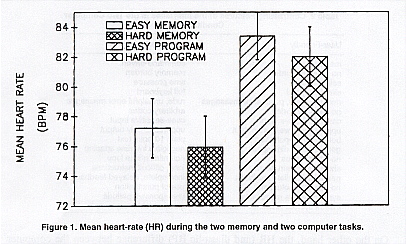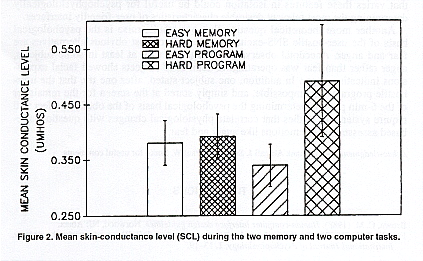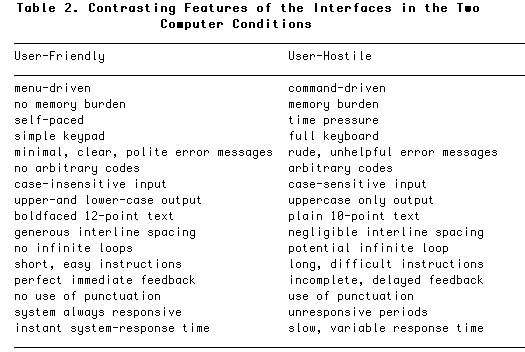
User-Hostile Systems and Patterns of Psychophysiological Activity
Paul Muter, John J. Furedy, Alex Vincent, and Ted Pelcowitz
University of Toronto
Requests for reprints should be addressed to Paul Muter, Psychology Department, University of Toronto, Toronto, Ontario M5S 3G3, Canada, e-mail muter@psych.utoronto.ca
Abstract - Psychophysiological measures, which are not contaminated by demand characteristics, are potentially useful for improving systems and for examining psychological processes in human-computer interaction. In this study we report the use of minute-by-minute scored heart-rate (HR) and skin-conductance level (SCL) in a 25-subject experiment. Each subject was presented with two simulated bank-transaction tasks, one user-friendly and the other user-hostile. To check whether any differences were due simply to sheer difficulty, easy (forward digit-span) and hard (backward digit-span) memory tasks were presented to all subjects. The HR was higher during the computer (problem-solving) tasks than the memory tasks, but was unaffected by task difficulty, whereas SCL was uniquely elevated during the hard (user-hostile) computer task. The HR result is interpreted as reflecting parasympathetic withdrawal, while the SCL result suggests that the user-hostile software produced sympathetic excitation of the sort associated with the fight-or-flight reaction. SCL may serve as a good measure of user-friendliness.
The extent of use of computers in 1992 is dramatically lower than predicted several years ago. As Time magazine ("What New Age?," 1991) put it, "High-tech gizmos for home and office are readily available but underused. The Information Age just isn't all it was cracked up to be." Why have computers not fulfilled their promise? One important reason may be that many systems elicit negative emotional responses and subsequent avoidance behavior. In the present study, psychophysiological measures of subjects using user-hostile and user-friendly systems are analysed in an attempt to better understand human-computer interaction. If user-hostile systems produce a particular pattern of psychophysiological activity, then psychophysiological measures may be a useful tool in diagnosing user-hostile systems and in elucidating the nature of the psychological processes elicited by these systems. Furthermore, modifying systems with the goal of altering psychophysiological responses may be an important general means of making computers more usable and palatable.
Psychophysiology measures subtle changes in physiological functions to study psychological processes (Furedy, 1983). Since the physiological changes in functions like skin conductance (SC and heart rate (HR) are not under conscious control, demand characteristics that are present both with behavioral and introspective (e.g., questionnaire) measures are eliminated. In addition, there are gross physiological differences of psychological relevance that can be distinguished by using different psychophysiological measures. For example, mobilization to deal with a psychological stimulus can produce merely the inhibition or withdrawal of the parasympathetic branch of the autonomic nervous system (PNS), or also the excitation or activation of the sympathetic nervous system (SNS). The latter physiological effect of SNS activation is associated with the fight-or-flight response, and with negative emotions like fear and anger. In contrast, PNS withdrawal is a more emotionally neutral event.
The psychological relevance of this distinction is illustrated by the repeated finding (e.g., Heslegrave & Furedy, 1979; for review of later studies, see Furedy, 1987) that doing a timed iterative subtraction task produces both SNS excitation and PNS inhibition (operating, involving significant mental effort), whereas listening to the numbers that will have to be subtracted produces only PNS withdrawal (encoding, involving minimal mental effort).
The distinction between PNS inhibition alone and PNS inhibition coupled with SNS excitation cannot be made with such single psychophysiological measures as HR acceleration, since HR, being supraventricular in origin, is significantly influenced by both SNS and PNS. Ventricular-based cardiac indices like T-wave amplitude, pulse transit time, and carotid dp/dt are more likely to reflect predominantly sympathetic influences, but these are all controversial (see, e.g., Furedy & Heslegrave, 1983; Heslegrave & Furedy, 1979) and also involve a relatively "high-tech" approach requiring the addition of considerable software and hardware resources.
The obvious advantage of using relatively simple technology is that claims made for certain psychophysiological results can be checked by more laboratories. The present study reports such a "low-tech" approach. We measured HR once per minute, and for the SNS index employed skin conductance level (SCL). Although the precise physiological basis of SCL is still not fully understood, it is psychophysiology's simplest and oldest measure. (SCL is sometimes called, somewhat imprecisely, the galvanic skin response, or GSR.) We presented subjects with two simulated bank-transaction tasks, one user-friendly and the other user-hostile. In addition, to assess the role of sheer difficulty in any obtained differences, easy and hard memory tasks (digit span) were also given to all subjects.
The questions of interest were the following. Does a user-hostile system produce any particular pattern of physiological change? If so, what is this pattern, and what psychological processes might it imply? Does this pattern differ from that produced by difficult tasks in general? Are such patterns of physiological activity - for example, SCL increase without HR increase versus HR increase without SCL increase - interpretable in terms of the SNS/PNS distinction?
METHOD
Subjects
Twenty-five volunteers (17 females) from an introductory psychology course served as unpaid participants. The average age was 25. They had all had some personal computer experience, on either a Macintosh, IBM, or IBM clone.
Apparatus
A portable blood pressure arm cuff (Copal UA 251) placed on the subject's left upper arm was used to measure HR, as well as systolic and diastolic blood pressure (BP). This instrument, once manually activated, automatically inflates the cuff, and takes HR and BP measurements during deflation. Continuous SCL was recorded, through a Coulbourn Instruments preamplifier (S71-22) onto a Narco (E & M Instruments) Physiograph (Model FOUR-A), via two Grass Ag/AgCl electrodes in conjunction with a Beckman NaCl electrode paste attached by adhesive tape to the volar surfaces of the subject's distal phalanges of first and second fingers of the nondominant hand. The computer programs were written for and implemented with a Macintosh 512K.
Procedure
Two memory and two computer tasks, each lasting 6 min, were presented in counterbalanced order to all subjects. The memory tasks were based on the Wechsler digit-span task, with forward and backward digit spans serving as the easy and difficult levels, respectively. In this task, digits are orally presented at the rate of one per second, and the subject is asked to repeat them back immediately. The number (span) is increased as long as the subject is able to repeat the series without error on at least one of two test trials, and the score is the number of digits that can be so repeated.
The computer tasks were based on the automated teller machines found at most chartered banks, and subjects were required to carry out a series of operations (transactions) specified on a sheet of paper. The easy (user-friendly) task required only the number keys for all operations, and the keyboard was covered so that only the number pad and the return and back-space keys were exposed: The access code was 532695. The on-screen instructions, indicating how to deposit, withdraw, and transfer, were clear and precise; they were menu-driven (via the numbered keys), and there was no time restriction for any of the transactions. Positive feedback that the transaction had been correctly executed was provided to the subject by a message appearing at the bottom of the screen: "PLEASE PROCEED TO THE NEXT TRANSACTION." In the unlikely event of an error, the wrong action would be performed. Otherwise, there was no negative feedback.
The hard (user-hostile) program required the whole range of keys for the transactions (including the shift key, since the program was case-sensitive); the access code was !A02?\. The on-screen instructions (for text, see Table 1) were in uppercase letters that were close together, and hence hard to read (note also that the last line refers to the meaningless concept of "unpacking bytes"); operations were not menu-driven, and the (case- sensitive) codes for each type of transaction (e.g., "Trfr", not "trfr," for transfer) had to be entered within a limited time. Each account (e.g., savings) had an arbitrarily associated number (e.g., 1). No positive feedback was provided at the end of any correctly executed transaction, but negative feedback was provided both for errors (loud buzzing sound from the computer, the message "FATAL ERROR' on the screen, and a 15-s period during which time the subject could not operate the computer) and for delays (loud buzzing sound and the message "TOO SLOW!!" on the screen).

RESULTS
The psychophysiological data available for analysis were the minute-by-minute HR and BP readings and corresponding SCL values scored on a minute-by-minute basis from the Physiograph chart, expressed in units of microSiemens. A test of the distributions revealed no significant departure from normality in the cardiovascular (HR and BP) scores, but a significant skewness (towards the low-scores end of the distribution) in the SCL scores. Accordingly, parametric statistical tests (analyses of variance [ANOVAs]) were applied to the cardiovascular scores, and nonparametric (sign- and ranks-tests) applied to the SCL scores. Figure 1 shows the mean HR data. The only significant effect was one due to the type of task, F(1, 24) = 7.05, p < .05. The computer tasks produced an acceleration relative to the memory tasks, but task difficulty had no effect on HR. The pattern of results for BP was similar but less reliable, with only diastolic BP yielding a significant type-of-task effect, F(l, 24) = 4.51, p < .05.


DISCUSSION
While the HR measure was sensitive only to the difference between the problem-solving computer tasks and the memory tasks, and not to the difficulty manipulation in either of the two sorts of tasks, the electrodermal SCL measure was uniquely elevated in the difficult, user-hostile computer condition. Although the underlying physiological mechanism of SCL changes is not fully understood, there is agreement that at least peripherally, the dominant neural substrata are SNS- rather than PNS-related. Accordingly, the results, taken together, suggest that interfacing with user-hostile systems may produce the increased sympathetic excitation that typically accompanies human fight-or-flight responses.
On the other hand, the HR (and diastolic BP) difference between the computer tasks (which require the solving of problems through symbol manipulation) and the memory tasks probably reflects greater PNS (vegetative) withdrawal for the computer tasks. The fact that there were no differences within type of tasks as a function of difficulty suggests that this vegetative withdrawal is an all-or-none effect that occurs when the organism is called upon to solve problems.

REFERENCES
Brown, C. M. (1988). Human-computer interface design guidelines. Norwood, NJ: Ablex.
Furedy, J. J. (1983). Operational, analogical, and genuine definitions of psychophysiology. International Journal of Psychophysiology, 1, 13-19.
Furedy, J. J. (1987). Beyond heart-rate in the cardiac psychophysiological assessment of mental effort: The T-wave amplitude component of the electrocardiogram. Human Factors, 29, 183-194.
Furedy, J. J., & Heslegrave, R. J. (1983). A consideration of recent criticisms of the T-wave amplitude index of myocardial sympathetic activity. Psychophysiology, 20, 204-211.
Heslegrave, R. J., & Furedy, J. J. (1979). Anticipatory HR deceleration as a function of perceived control and probability of aversive loud noise: A deployment of attention account. Biological Psychology, 7,147-166.
Nickerson, R. S. (1986). Using computers: Human factors in information systems. Cambridge, MA: MIT Press.
Norman, D. A. (1988). The psychology of everyday things. New York: Basic Books.
Shneiderman, B. (1987). Designing the user interface: Strategies for effective human-computer interaction. Reading, MA: Addison-Wesley.
What new age?. (1990, August 12). Time, pp. 42-44.